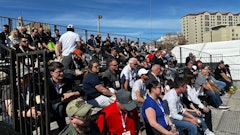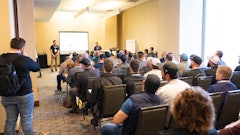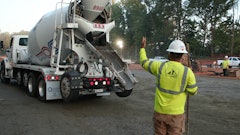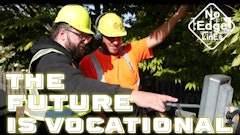
Many contractors know that when business is slow, you need ways to keep busy and continue making money. Pavement striping has long been known as a relatively easy business to break in to and learn the basics. If you’re thinking of adding a walk-behind striper to your arsenal, there are some things you should consider before pulling the trigger on a purchase.
First things first – how much work are you planning on doing with your new striper? “A ‘new’ line-striping contractor must ensure that he/she purchases the correct line striper for the amount of line striping being done,” says Tom Heine, specialty business sales manager at Titan Tool. “Striping jobs per week, total gallons per week, estimating/ bidding, and scope of overall jobs being performed must all be taken into consideration first when purchasing a line striper.”
Tim Wehner, Graco Inc. global product marketing manager, adds that you should consider startup costs and also research the competition before you buy because knowing what they are doing to be successful is a great advantage before you dive into buying your own machine. “You need to see what they use, what they charge and when they stripe (day or night),” Wehner says.
Striper Feature 1: Number of Guns
Stripers are available with either one or two guns and you need to decide what configuration is best for the work you’ll be doing. Many contractors will use a one-gun machine for simple parking lot striping work where they’re striping a single line on a smaller job. Manufacturers say that one-gun line stripers are great for learning the business and are typically lighter and much easier for one person to maneuver and unload.
If your jobs are going to extend beyond a parking lot, consider a two-gun model. Striping jobs for two-gun stripers will be more complicated; double lines, curbs, stencils, hard to reach angles etc. Shooting a curb with a two-gun striper, for example, is particularly easier as you can point one gun straight down on the curb to paint the top, while the other gun is hitting the face in just one pass.
“The versatility of having a two-gun line striper at your fingertips is key,” Heine says. “You don't always need a two-gun option, but when you do, it's nice to have the option.”
Striper Feature 2: Performance
Manufacturers offer a wide array of walk-behind machines to meet the specific needs and desires of a contractor. Once you’ve decided whether you want a one- or two-gun unit, take a look at the different performance elements you may want your striper to have.
SPEED — What is the machine's spraying speed? This is measured by how many linear feet per minute the striper can cover.
ENGINE — How large of an engine do you want (CC’s)? This will affect the line-striper speed and overall pump performance of the coating being applied.
Electric start or pull start? Manufacturers say this comes down to personal preference.
GALLONS PER MINUTE — What is the pump capacity of the machine? As a contractor becomes more proficient in her task, she often can work at a faster rate to get jobs done. In that case she will be looking for a striper that can perform at more than two gallons of paint per minute and can support multiple guns.
PUMP DRIVE — Is it clutch or hydraulic driven? A belt-driven clutch assembly has a variable sheave that runs off the engine to a set of wheel cogs. These cogs move against the rear wheels and power the machine forward with a belt. Hydraulic drive systems have a throttle-type valve that moves forward from a neutral position to increase the speed. “The hydraulic systems require a larger horsepower engine and a hydraulic pump and reservoir,” says Charles Hess, tech equipment specialist, at M-B Companies Inc. “This type of drive is much more expensive. A clutch machine is great for startup contractors for their ease of use, while the hydraulic machines tend to be more powerful.”
MAX TIP SIZE — What is the largest tip the line striper will support? Larger tip sizes will allow you to move faster while applying the proper mil thickness of paint.
Striper Feature 3: Air vs. Airless
Air-powered systems require compressed air and a hopper to atomize coatings. Air-atomized sprayers are simpler in design and can be less expensive to maintain. With this type of system, though, the coating typically needs to be thinned before striping.
In the past 10 years, there has been a large movement from conventional air-spray systems to airless technology. This type of system uses gasoline or electricity to power the engine and a clutch or hydraulics to power the pump. “Contractors who are looking to add to their fleet of parking lot machines should consider upgrading to airless walk-behind machines,” Hess says. “These machines put down a better line than air-atomized machines. The paint line will dry faster when airless is used only because you are not injecting moisture into the paint line as you do with air-atomized units.”
Striper Feature 4: Accessories
When you’re just learning the business, everything you do may seem like a challenge. The more you know, the more you’ll see there are tools and accessories designed to make striping easier.
Spray Tips: It is always a good idea to have a variety of tip sizes on hand that fit your striper. This will give you versatility for striping single thin lines, to thicker curbs.
Light Kits: “A must have for contractors striping at night,” says Heine.
Gun Configuration: Be sure you buy a striper that has a user-friendly gun configuration. Guns should be easy to move up and down, left and right. The entire gun system can be mounted on the left or right side, front or back of the line-striper depending on the job you’re doing. Heine says that gun extensions are also a great tool for painting stencils (handicap logos, fire lane, reserved etc.).
Cleaning Agent: Have this on hand to clean and protect your spray system against rust and corrosion. “If the machine is maintained, the performance will be greater than a machine that is left sit with paint in the lines and gun,” Hess says. This could cause plugging in the strainers, hoses and paint guns.
Piston Lube: Specially formulated to prevent material from adhering to the piston rod and keeps your packings and seals lubricated, which extends the overall life of the pump.
Laser Pointer: Attached to the striping machine, this is a great tool for keeping your lines straight.
Glass Bead Dispenser: Wehner says about 20% of all striping jobs require glass beads so your striper should have a glass bead dispenser. Glass bead dispensing systems mount on to your striper and are designed to deposit retro-reflective glass beads on traffic paint lines. When the gun(s) are actuated, the bead dispenser door opens simultaneously with the gun and a shower of beads the width of the dispenser is then deposited onto the wet paint line(s). The amount of beads dispensed is easily adjustable, but Heine adds six pounds of beads per gallon is a general rule of thumb.
Stencils: When choosing a stencil, manufacturers say to go with one that is durable and lays flat on surfaces.
Spray Shield: A spray shield can help to protect the spray pattern from the wind, which limits overspray and material costs. They are adjustable and easy to remove.
Growing Your Business
As a line striping contractor's business grows, it is necessary to add equipment to the fleet. “Being efficient and profitable is key,” says Heine. “Having two or more stripers is a good way to be efficient if you’re working on larger jobs as you do not have to clean the machine if you’re using different colors, like white stripes and blue for handicap stalls.”
Wehner agrees, adding that “the larger the contractor, the more likely they have dedicated units. Changing out colors is time consuming and time is money,” he says.
Striper technology can change in the blink of an eye. These days, there are inexpensive gas-powered line stripers, specially designed spray tips (such as two spray patterns built into one tip), automatic layout systems, self-propelled systems, upgraded laser pointers, pressurized bead systems and even a floating gun kit (for bumpy parking lots). The point is, there are many walk-behind units on the market, each with its specific advantages and preferred applications. And there are many options and accessories to consider. Also, keep in mind that a line-striper is also a “general purpose” paint sprayer and can be used to paint houses, commercial buildings, etc. Manufacturers say contractors need to make sure to know exactly what they’re looking to get out of your new striping unit, and do your research before making a purchase.




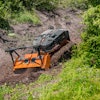

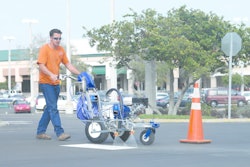
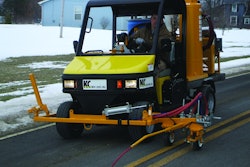

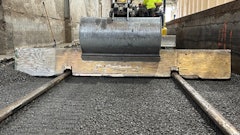

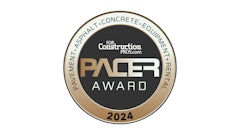

![Pavement Awards 2025[main]](https://img.forconstructionpros.com/files/base/acbm/fcp/image/2024/05/PavementAwards_2025_main_.664253a724bb1.png?ar=16%3A9&auto=format%2Ccompress&bg=fff&fill-color=fff&fit=fill&h=135&q=70&w=240)
